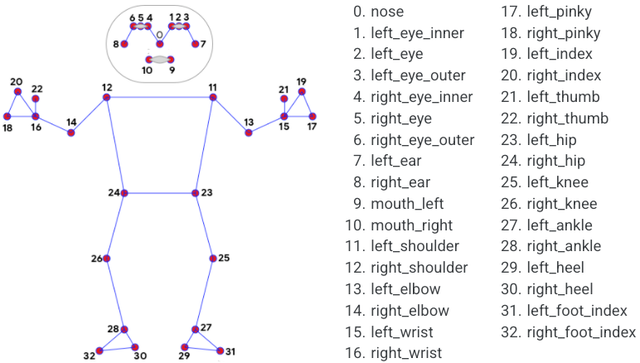健身也内卷?这届网友用 Python 掌握了做标准俯卧撑的秘诀
【CSDN 编者按】自己在家锻炼时,我们很难知道自己的动作是否标准。本文作者用Python写了一个可以检测俯卧撑动作是否标准的程序,一起来看看他是怎么做的。
原文链接:https://aryanvij02.medium.com/push-ups-with-python-mediapipe-open-a544bd9b4351
https://github.com/aryanvij02/PushUpCounter
本文为CSDN翻译,转载请注明来源出处。
译者 | 章雨铭 责编 | 屠敏
出品 | CSDN(ID:CSDNnews)
在新加坡军队中,有一种测试叫做IPPT(个人身体素质测试)。这个测试的困难不在于它对体力的要求有多高,而在于用来计算做俯卧撑和仰卧起坐次数的电子机器。
和大多数人一样,我的俯卧撑动作总是不达标(根据机器的意见)。此外,由于缺乏参照机器标准的练习,许多NSMen(已经完成两年强制性服役的人)在IPPT测试中都难以取得好成绩。
因此,我决定使用mediapipe和OpenCV创建一个程序,跟踪我们的俯卧撑动作,确保我们每一个俯卧撑动作都达标。

由mediapipe姿势模块检测到的肢体关节
import cv2 import mediapipe as mp import math class poseDetector() : def __init__(self, mode=False, complexity=1, smooth_landmarks=True, enable_segmentation=False, smooth_segmentation=True, detectionCon=0.5, trackCon=0.5): self.mode = mode self.complexity = complexity self.smooth_landmarks = smooth_landmarks self.enable_segmentation = enable_segmentation self.smooth_segmentation = smooth_segmentation self.detectionCon = detectionCon self.trackCon = trackCon self.mpDraw = mp.solutions.drawing_utils self.mpPose = mp.solutions.pose self.pose = self.mpPose.Pose(self.mode, self.complexity, self.smooth_landmarks, self.enable_segmentation, self.smooth_segmentation, self.detectionCon, self.trackCon) def findPose (self, img, draw=True): imgRGB = cv2.cvtColor(img, cv2.COLOR_BGR2RGB) self.results = self.pose.process(imgRGB) if self.results.pose_landmarks: if draw: self.mpDraw.draw_landmarks(img,self.results.pose_landmarks, self.mpPose.POSE_CONNECTIONS) return img def findPosition(self, img, draw=True): self.lmList = [] if self.results.pose_landmarks: for id, lm in enumerate(self.results.pose_landmarks.landmark): #finding height, width of the image printed h, w, c = img.shape #Determining the pixels of the landmarks cx, cy = int(lm.x * w), int(lm.y * h) self.lmList.append([id, cx, cy]) if draw: cv2.circle(img, (cx, cy), 5, (255,0,0), cv2.FILLED) return self.lmList def findAngle(self, img, p1, p2, p3, draw=True): #Get the landmarks x1, y1 = self.lmList[p1][1:] x2, y2 = self.lmList[p2][1:] x3, y3 = self.lmList[p3][1:] #Calculate Angle angle = math.degrees(math.atan2(y3-y2, x3-x2) - math.atan2(y1-y2, x1-x2)) if angle < 0: angle += 360 if angle > 180: angle = 360 - angle elif angle > 180: angle = 360 - angle # print(angle) #Draw if draw: cv2.line(img, (x1, y1), (x2, y2), (255,255,255), 3) cv2.line(img, (x3, y3), (x2, y2), (255,255,255), 3) cv2.circle(img, (x1, y1), 5, (0,0,255), cv2.FILLED) cv2.circle(img, (x1, y1), 15, (0,0,255), 2) cv2.circle(img, (x2, y2), 5, (0,0,255), cv2.FILLED) cv2.circle(img, (x2, y2), 15, (0,0,255), 2) cv2.circle(img, (x3, y3), 5, (0,0,255), cv2.FILLED) cv2.circle(img, (x3, y3), 15, (0,0,255), 2) cv2.putText(img, str(int(angle)), (x2-50, y2+50), cv2.FONT_HERSHEY_PLAIN, 2, (0,0,255), 2) return angle def main(): detector = poseDetector() cap = cv2.VideoCapture(0) while cap.isOpened(): ret, img = cap.read() #ret is just the return variable, not much in there that we will use. if ret: img = detector.findPose(img) cv2.imshow('Pose Detection', img) if cv2.waitKey(10) & 0xFF == ord('q'): break cap.release() cv2.destroyAllWindows() if __name__ == "__main__": main()
以上是这个程序的代码。
上面的代码来源于PoseModule.py,有以下几个功能:
激活mediapipe的姿势检测模块。
检测人体。
根据模型找到人体上不同肢体关节的位置。(肢体显示在上面的图片中)。
查找关节之间的角度(取决于你选择的关节)。对于我的俯卧撑程序,我选择找到肘部、肩部和臀部的角度,因为这些对俯卧撑动作的标准至关重要。
接下来是实际的俯卧撑计数的代码。我们使用PoseModule并确定一个俯卧撑合格与否的标准。
import cv2 import mediapipe as mp import numpy as np import PoseModule as pm cap = cv2.VideoCapture(0) detector = pm.poseDetector() count = 0 direction = 0 form = 0 feedback = "Fix Form" while cap.isOpened(): ret, img = cap.read() #640 x 480 #Determine dimensions of video - Help with creation of box in Line 43 width = cap.get(3) # float `width` height = cap.get(4) # float `height` # print(width, height) img = detector.findPose(img, False) lmList = detector.findPosition(img, False) # print(lmList) if len(lmList) != 0: elbow = detector.findAngle(img, 11, 13, 15) shoulder = detector.findAngle(img, 13, 11, 23) hip = detector.findAngle(img, 11, 23,25) #Percentage of success of pushup per = np.interp(elbow, (90, 160), (0, 100)) #Bar to show Pushup progress bar = np.interp(elbow, (90, 160), (380, 50)) #Check to ensure right form before starting the program if elbow > 160 and shoulder > 40 and hip > 160: form = 1 #Check for full range of motion for the pushup if form == 1: if per == 0: if elbow <= 90 and hip > 160: feedback = "Up" if direction == 0: count += 0.5 direction = 1 else: feedback = "Fix Form" if per == 100: if elbow > 160 and shoulder > 40 and hip > 160: feedback = "Down" if direction == 1: count += 0.5 direction = 0 else: feedback = "Fix Form" # form = 0 print(count) #Draw Bar if form == 1: cv2.rectangle(img, (580, 50), (600, 380), (0, 255, 0), 3) cv2.rectangle(img, (580, int(bar)), (600, 380), (0, 255, 0), cv2.FILLED) cv2.putText(img, f'{int(per)}%', (565, 430), cv2.FONT_HERSHEY_PLAIN, 2, (255, 0, 0), 2) #Pushup counter cv2.rectangle(img, (0, 380), (100, 480), (0, 255, 0), cv2.FILLED) cv2.putText(img, str(int(count)), (25, 455), cv2.FONT_HERSHEY_PLAIN, 5, (255, 0, 0), 5) #Feedback cv2.rectangle(img, (500, 0), (640, 40), (255, 255, 255), cv2.FILLED) cv2.putText(img, feedback, (500, 40 ), cv2.FONT_HERSHEY_PLAIN, 2, (0, 255, 0), 2) cv2.imshow('Pushup counter', img) if cv2.waitKey(10) & 0xFF == ord('q'): break cap.release() cv2.destroyAllWindows()

有个需要注意的地方在第17-21行。确定从相机捕捉到的图像的分辨率,并在绘制俯卧撑计数的矩形时调整像素值,等等。(第68-82行)。
我们完成了!一个能确保动作标准的俯卧撑计数软件。没有完全俯下?不算数! 膝盖放在了地上?不算数!
快乐的做俯卧撑吧!
![]()
《新程序员003》正式上市,50余位技术专家共同创作,云原生和数字化的开发者们的一本技术精选图书。内容既有发展趋势及方法论结构,华为、阿里、字节跳动、网易、快手、微软、亚马逊、英特尔、西门子、施耐德等30多家知名公司云原生和数字化一手实战经验!























评论